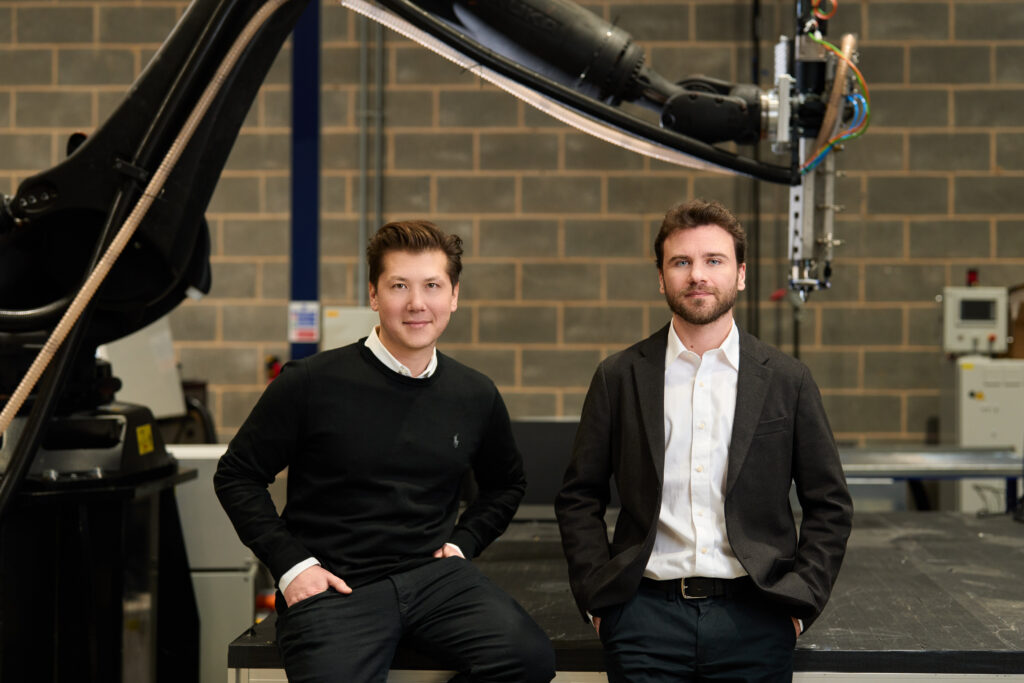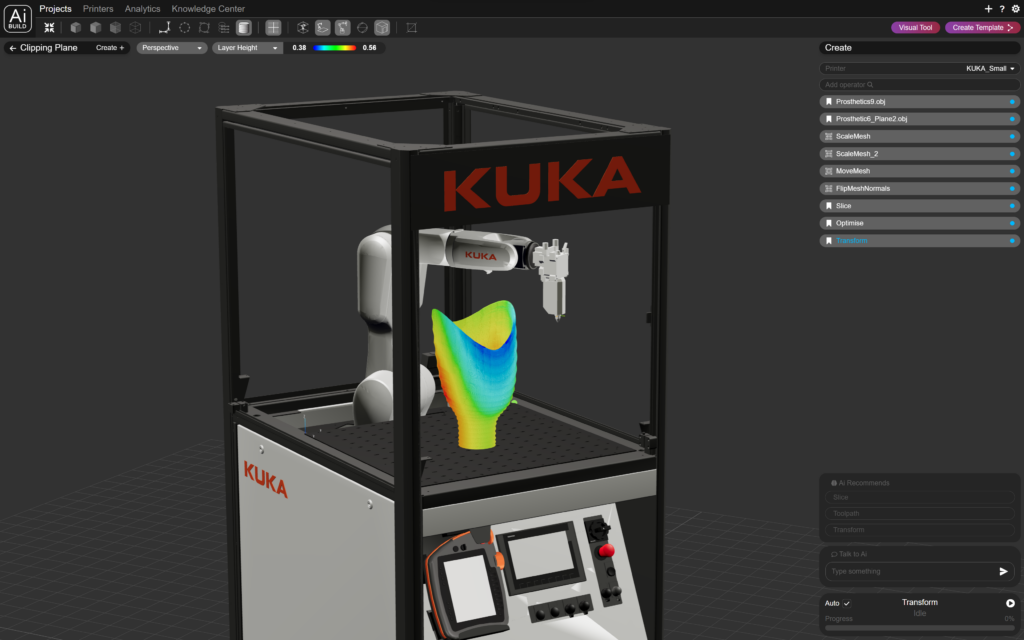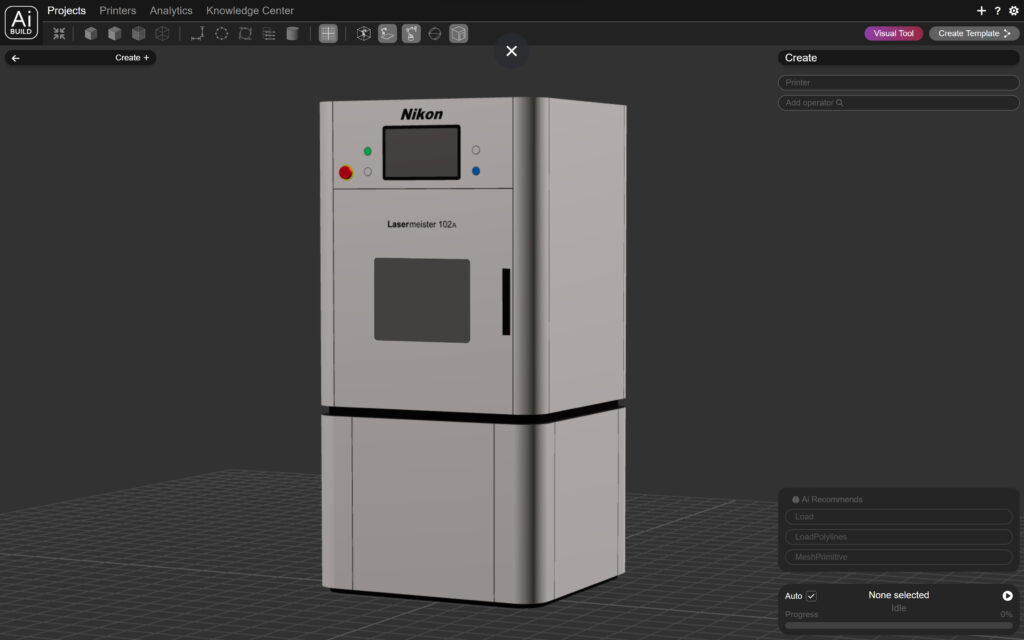When there’s a gold rush, the best bet is to invest in picks and shovels. When it comes to the additive manufacturing (AM) industry, that means backing the software that’s driving the technology—which may be why Nikon has just been announced as a strategic investor in Ai Build’s Series A round. To drive its artificial intelligence (AI)-driven toolpath optimization software-as-a-service, the London-based startup just closed $8.5 million in funding, led by IQ Capital, with participation from existing investors including Superseed, ACT Venture Partners, Atlas Ventures (UK) and Seedcamp.
Mason Sinclair, Principal at IQ Capital, said of the deal, “We’re excited to be working with Ai Build as they bring their automated platform for additive manufacturing to the global market. AM represents a $16bn segment of the manufacturing industry and is growing rapidly at over 20% per annum. This is an exciting time of transformation for the industry and we believe that AI Build will play a critical role in unlocking its potential.”
To learn more, we spoke to Daghan Cam, Co-Founder & CEO, and Michail Desyllas, Co-Founder & COO, of Ai Build. The duo opened up about their journey from architectural experts solving complex geometric problems to becoming leaders in the 3D printing industry.
A Niche in Toolpath Optimization
Both Cam and Desyllas have backgrounds as architects, having worked at Zaha Hadid Architects for over a decade. This experience was instrumental in their journey into AM. Their specialized skill set allowed them to recognize a niche—optimizing 3D printing processes, which are notoriously prone to errors.
“Our main focus was on solving complex geometrical design problems for large-scale projects such as airports and cultural centers worldwide. Whenever structural, navigational, or sustainability issues arose in these buildings, we were asked to give solutions as a whole, a design system rather than just a form” Desyllas said. “This passion led us to realize that existing software couldn’t meet the architectural demands for complex geometries in construction. As a result, we had to develop bespoke software solutions for designing manufacturing strategies to serve design systems.”
When it was founded in 2015, Ai Build first focused on robotic 3D printing, developing a combination of software and hardware for optimizing plastic extrusion. With its AiSync software, Ai Build was able to develop a machine learning-based method for making the perfect toolpath for depositing melted materials.
“It’s almost never possible to get it right the first time, which is why our primary goal is to automate the entire process,” Cam said. “This will enable AM, which has immense potential, to reach more applications and use cases. It’s all about lowering the barrier to entry.”
Broadening Horizons
Over time, Ai Build transitioned from a hardware and software mix to a software-centric model. This strategic shift helped the company forge partnerships with hardware manufacturers like Kuka and Weber Additive. The startup’s software, initially a desktop application, is now a cloud-based platform, reflecting the broader industry trend.
“Our evolution and history helped us gain trust with hardware partners. They saw that we understood hardware struggles while developing deeply integrated software solutions. To scale and encourage industry adoption, we needed to be deeply involved in both the software and hardware aspects,” Desyllas said.
This strategic pivot also allowed Ai Build to join a cohort that included giants like Boeing, Rolls-Royce, and GKN through Boeing’s Aerospace Xelerated portfolio, giving them an entry into industries like aerospace and automotive. They now collaborate with about 25 different hardware manufacturers, focusing mainly on enterprises with multiple machines.
Moreover, Ai Build was able to expand beyond material extrusion with robotic arms to include gantry-based systems and a variety of materials. This includes 3D printers large and small and materials ranging from plastic and metal to cement and epoxies. Ai Build even has an ongoing government-funded project on laser powder bed fusion in collaboration with Domin.
“Our platform is built to be process-agnostic and material-agnostic, but strategically, we are focusing on certain types of machines,” Cam said. “The goal is to build strong partnerships with hardware companies. We aim to deeply embed our product into the machines rather than providing third-party software that feels disconnected. Because of this, we have a specific focus on certain technologies, such as robotics. One of our key advantages compared to more generic software is our ability to speak the same language as all the machine components—sensors, cameras, etc. This makes our platform feel much more natural to our customers, almost like a bundled product rather than third-party software.”
ChatGPT for 3D Printing
More recently, Ai Build added the ability to use natural language to command the software, meant to further lower the barrier to entry. Relying on large language models like GPT4, users can now “Talk to AiSync” in their own words, with the software able to interpret the commands and generate the proper workflow. So far, this capability has been in beta development, but will be expanded to all of its customers at Formnext in November.
“Even if you’re not an expert in 3D printing, you can tell the system what you want to achieve, and we translate that intent into smart instructions automatically. This is one of our most ambitious projects at the moment,” Cam said.
According to the co-founder, all a user would need to do is tell AiSync to “Slice my bunny with a two-millimeter layer height” and the system will create the associated workflow. For Ai Build’s hardware partners, the ability to show or hide specific settings is necessary for protecting IP; however, it also allows the community to develop more advanced workflows. For instance, the top and bottom parts of an object could have different layer height fields, settings that can be consolidated into a template with just two options, simplifying the user interface.
“What’s cool is that everything is parametric,” Desyllas said. “The same workflow that applies to a bunny design can be applied to a bear design, allowing for repeatable engineering workflows. Everything is interconnected, data-driven and repeatable, which are the decisions we made on the architecture of our platform from day one. The ultimate goal is to make 3D printing accessible even for individuals with minimal engineering knowledge. We aim to enable this at a highly engineering-focused level, rather than just offering basic slicing options. This granular control is essential, as it minimizes the number of errors and reduces the need for multiple prototypes. We’re working to streamline the 3D printing process, cutting down on the trial and error that we all know is often required.”
Recent Funding
The recently closed Series A funding allows Ai Build to double its team size and expand its presence in the United States. The new funds will be primarily used for further software development. The company plans to introduce new tools for machine learning and monitoring processes, particularly beneficial for highly regulated industries like aerospace. Crucially, the engineering teams of Ai Build and Nikon will combine their experience in software and hardware technologies to advance the state of the art in AM. So far, Nikon has said that Ai Build is compatible with its DED system, the Lasermeister 100A series.
Yuichi Shibazaki, Corporate Vice President and Officer in charge of the Next Generation Project Division at Nikon, said of the investment, “Ai Build offers extensive solutions that enable automated workflows, bringing efficiency and sustainability to the field of AM. In tandem with Nikon’s capabilities, together we will deliver innovative solutions that revolutionize AM.”
This is just the latest move by Nikon in the 3D printing space, which previously included the purchase of SLM Solutions and Morf3D, as well as investments into Hybrid Manufacturing Technologies and Optisys. The Japanese giant situated the Ai Build investment, made through the Nikon-SBI Innovation Fund, as part of this larger Medium-Term Management Plan, announced in April 2022. The company noted: “Nikon emphasized strengthening digital manufacturing business with a particular focus on positioning material processing as a growth driver. Leveraging long-standing expertise in opto-electronics technologies and precision control technologies, Nikon, in collaboration with Ai Build, will drive innovation in the manufacturing industry by delivering tailored solutions that align with customers’ modeling needs.”
With their roots in architectural innovation and a strong focus on engineering solutions, Ai Build has its sights set on making 3D printing accessible even to individuals with minimal engineering knowledge. Their next step? To continue scaling 3D printing for broader industry adoption, thereby setting the stage for the next era of additive manufacturing.
“For us, this marks a turning point as we transition from the seed stage to a growth stage. In the last two years, we have seen strong traction in the aerospace and automotive sectors and have built a lot of strong customer cases,” Cam said. “With the recent funding, we are scaling everything. We’ve already doubled the size of our team in the last three months. Our main focus for the next two years is to acquire new customers and expand into new applications and machine types, thereby making the platform more widely used in enterprises.”
The team will also use the investment to establish a subsidiary in the US, facilitating their North American expansion, as well as to further their growth in Europe.
Subscribe to Our Email Newsletter
Stay up-to-date on all the latest news from the 3D printing industry and receive information and offers from third party vendors.
You May Also Like
Gorilla Sports GE’s First 3D Printed Titanium Cast
How do you help a gorilla with a broken arm? Sounds like the start of a bad joke a zookeeper might tell, but it’s an actual dilemma recently faced by...
Nylon 3D Printed Parts Made More Functional with Coatings & Colors
Parts 3D printed from polyamide (PA, Nylon) 12 using powder bed fusion (PBF) are a mainstay in the additive manufacturing (AM) industry. While post-finishing processes have improved the porosity of...
$25M to Back Sintavia’s Largest Expansion of Metal 3D Printing Capacity Since 2019
Sintavia, the digital manufacturing company specializing in mission-critical parts for strategic sectors, announced a $25 million investment to increase its production capacity, the largest expansion to its operations since 2019....
Velo3D Initiates Public Offering in a Bid to Strengthen Financial Foundations and Drive Future Growth
Velo3D (NYSE: VLD) has been among a number of publicly traded 3D printing firms that have attempted to weather the current macroeconomic climate. After posting a challenging financial report for 2023,...



































